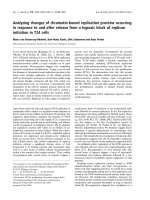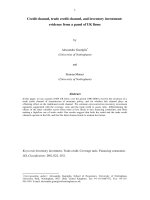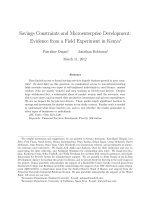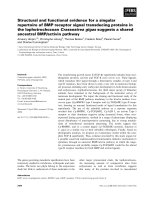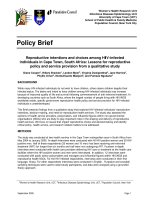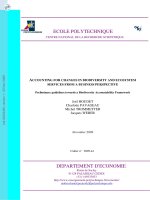Technology, Computers and Wages: Evidence from a Developing Economy
Bạn đang xem bản rút gọn của tài liệu. Xem và tải ngay bản đầy đủ của tài liệu tại đây (153.4 KB, 24 trang )
Technology, Computers and Wages:
Evidence from a Developing Economy
Chris N. Sakellariou
B2-B64, Nanyang Business School
Nanyang Technological University
Singapore, 639798
Email:
Harry A. Patrinos
The World Bank
Washington, D.C.
Email:
JEL: J31, I21, O33
Abstract: Increasing returns to schooling and rising inequality are well documented for
developed countries and for some developing countries. The growing demand for skills is
associated with recent technological developments. It is argued that computers in the
workplace represent one manifestation of these changes. Research in the United States
and developed countries documents a premium for computer use. However, there is
recent evidence suggesting that computer skills by themselves do not command a wage
premium. This paper reviews the literature and uses data from a survey of higher
education graduates in Vietnam. The results support the unobserved heterogeneity
explanation for computer wage premiums. The results suggest that computers may make
the productive workers even more productive. However, given the scarcity of computers
in low-income countries, an operational strategy of increasing computer availability and
skills would seem to offer considerable hope for increasing the incomes of the poor.
World Bank Policy Research Working Paper 3008, March 2003
The Policy Research Working Paper Series disseminates the findings of work in progress to encourage the
exchange of ideas about development issues. An objective of the series is to get the findings out quickly, even if
the presentations are less than fully polished. The papers carry the names of the authors and should be cited
accordingly. The findings, interpretations, and conclusions expressed in this paper are entirely those of the
authors. They do not necessarily represent the view of the World Bank, its Executive Directors, or the countries
they represent. Policy Research Working Papers are available online at .
___________________
* The authors are grateful to Lex Borghans, George Psacharopoulos, Christopher Shaw and Bas
ter Weel for comments on an earlier version.
I.
Introduction
Increasing returns to schooling and rising inequality is well documented for
developed countries and for some developing countries.
Many believe that a
fundamental change has occurred in the relationship between education and earnings,
reflecting increased and high demand for skilled workers. The demand for educated
labor is associated with important technological developments that have taken place in
recent years.
It has been argued that computers in the workplace represent one
manifestation of these changes. Researchers in the United States and other developed
countries have documented a substantial premium for computer use. However, there is
recent evidence suggesting that computers in the workplace are not responsible for the
change in wages, despite the fact that significant changes have occurred in the workplace
reflecting technological and organizational changes that have resulted in increased
demand for skilled labor. This paper reviews the literature from developed countries and
the scant work on this topic for developing countries. Survey data taken from surveys of
higher education graduates in Vietnam is used to test various hypotheses about the impact
of computer use on wages and the determinants of computer use.
II.
What do computer wage premiums reflect?
The computer is an example of an organizational change that requires workers
with an enhanced ability to learn. This change, it is argued by many, has caused an
increase in the demand for educated labor and, consequently, an increase in the returns to
schooling and rising earnings inequality. For the years between 1984 and 1989, the
1
percentage of workers who reported using a computer at work increased by over 50
percent (Krueger 1993), in the United States.
In an attempt to empirically examine whether employees who use a computer at
work earn a higher wage rate than otherwise similar workers who do not use a computer,
Krueger (1993) shows that workers who use computers at their job earn roughly a 10 to
15 percent higher wage rate (see Table 1). Therefore, the expansion in computer use
during the decade of the 1980s can account for between one-third and one-half of the
observed increase in the rate of return to education (Krueger 1993). Moreover, the
premium is associated with the use of computers for productive purposes, such as email,
bookkeeping, desktop publishing and inventory control.
However, there is some doubt cast on these estimates. It is argued that computers
have not changed the wage structure in the sense implied by Krueger and others. Rather,
it is asserted that more productive workers use computers. In other words, computers in
the workplace do not themselves create a wage premium for a given worker. Rather,
more able workers tend to work at jobs that require the use of a computer. The results
would suggest that computer users possess unobserved skills that are rewarded in the
labor market or that computers were first introduced in higher paying jobs.
In a re-analysis of Krueger's original paper, using German data, DiNardo and
Pischke (1997) confirm that estimated wage differentials associated with computer use in
Germany are very similar to the United States differential. But they also find large
differentials for on-the-job use of calculators, pens or pencils, or for those who work
2
while sitting down. They conclude that wage differentials associated with on-the-job
computer use are the result of unobserved heterogeneity.
Author
Table 1: Wage Impacts of Computer Use
Country
Krueger 1993
United States
Boozer, Krueger and Wolkon 1992
Hamilton 1997
Handel 1999
Krashinsky 2000
Borland, Hirschberg and Lye 1999
Miller and Mulvey 1997
Reilly 1995
Morrissette and Drolet 1998
Entorf and Kramarz 1997
Entorf and Kramarz 1998
Entorf, Gollac and Kramarz 1999
Asplund 1997
United States
United States
United States
United States
Australia
Australia
Canada
Canada
France
France
France
Finland
Dinardo and Pischke 1997
Haisken-DeNew and Schmidt 1999
Oosterbeek 1997
Arabsheibani, Emami and Marin 1996
Arabsheibani and Marin 2000
Bell 1996
Green 1998
Borghans and Ter Weel 2000a
Sakellariou and Patrinos 2000
Germany
Germany
Netherlands
United Kingdom
United Kingdom
United Kingdom
United Kingdom
United Kingdom
Vietnam
1983
1989
1987
1989
1991
1993
Wage Impact (%
increase over non-user)
15.0
18.0
22-23
13-25
7
0
10-18
10-15
15.5
14
2-10
2-20
1-18
8.4
8.1
6.4
0
17
1-7
11
20-23
19
13
13-18
21
10-14
Borghans and ter Weel (2000d), however, suggest another interpretation. They
argue, based on analysis of German and United Kingdom data, that the computer wage
premium does not reflect returns to computer skills. Rather, the wage premium merely
reflects the fact that computer costs are more easily recovered from high wage workers.
Also, they argue, the wage premium associated with pens reflects returns to specific
writing skills, such as writing documents.
3
In an analysis of a sample of twins,
Krashinsky (2000), after controlling for selection, finds that computers do not have a
significant effect on wages. Using Australian data, and disaggregating by a number of
factors and controlling for worker’s computer knowledge, Borland, Hirschberg and Lye
(1999) get mixed results on the impact of computers on earnings. In an attempt to control
for individual heterogeneity, Haisken-DeNew and Schmidt (1999) use panel data, and
control for computer-related skills, and find that computer use at work increases earnings
by only 1 percent, down from 7 percent when individual heterogeneity is not controlled
for in the model. This confirms the results of Entorf, Gollac and Kramarz (1999) and
Entorf and Kramarz (1997, 1998), who use French panel data to control for individual
ability, and find a very small computer wage premium. When other factors associated
with earnings are introduced in the wage equation, the returns to computer use fall to 7
percent using United States data (Handel 1999).
However, Bell’s (1996) attempt to control for individual heterogeneity does not
lead to the same conclusion. Bell (1996) uses British panel data and controls for ability
and test scores in mathematics and reading comprehension, as well as planning ability
and organizational capabilities. He finds a computer wage premium of 13 percent.
Green (1998) also finds a computer wage premium of 13 percent, and although panel data
is not used, this holds after controlling for a great number of different measures of skill,
such as professional communication and problem-solving skills, variety of tasks,
participation in “quality circles,” and learning time. Reilly (1995) examines the earnings
impact of computer use in Canada with a sample of 607 employees working in 60
establishments in 1979, a period perhaps before the personal computer "revolution."
Without controlling for establishment size, Reilly (1995) finds employees who have
4
access to a computer earn 15.5 percent higher pay. In Finland, the computer premium
declines over time (Asplund 1997). In fact, the premium becomes insignificant (see
Figure 1).
Figure 1: Computer Wage Premium over Time in Finland
9%
8%
7%
6%
5%
4%
3%
2%
1%
0%
1986
1987
1988
1989
1990
1991
1992
1993
1994
Source: Asplund 1997
Bresnahan (1999) argues that ICT is changing whole organizations, by leading to
the replacement of back-office jobs and increasing the importance of front-office skills
and leadership. Individual personal computers (PCs) are not changing the market, but
networks of PCs and office automation are changing the way people work and are being
rewarded. The nature of work is being restructured in workplaces in industrial countries,
whereby multitasking is rewarded and broad-based education is preferred (Lindbeck and
Snower 1996). Cappelli and Carter (2000) show that while computer use has an effect on
wages of managers and supervisors, it is computer use by their subordinates that is the
important factor, lending support to Bresnahan's theory that it is computers and
workplace organization changes that are responsible for wage structure changes. In a
5
very interesting and innovative case study, Autor, Levy and Murnane (2000) document
the impact of technological change on two departments within the same commercial
bank. They show that the same technological change can result in both computer-labor
substitution and in computer-skill complementarity (skill-biased technological change),
depending on the nature of work and organization of the workplace. They also show that
technological change and organizational change are interdependent. The results also
suggest that conceptual and problem-solving skills are one set of skills that are likely to
be made more valuable by technology.
In an attempt to examine how computer
technology complements skilled labor, Autor, Levy and Murnane (2001) look at what
computers do in order to model and test how computers alter the demand for skilled
labor. They find that computers are associated with declining relative industry demand
for routine skills and increased demand for non-routine cognitive skills.
The belief that computers represent skill-biased technological change and that
computer skills are being rewarded in the labor market is challenged by Borghans and ter
Weel (2000b) using a unique British survey that collected information on a number of
skills. They conclude that it does not require high level computer skills to operate
computers for the majority of workers. Controlling for computer usage (ranging from
“essential” to “not very important”), sophistication of usage (“advanced” to “simple”)
and computer skills (“very high” to “very low”), they show that there are returns to usage
and sophistication, but to not to skills. They argue that the use of computers is associated
with high wage workers, who could save time on some tasks. Eventually, all workers
will receive computers, once the cost goes down sufficiently (see also Borghans and ter
6
Weel 2000c). There are implications for these findings, argue the authors. Among these,
it may not make sense to invest heavily in computer skills when educating pupils.
Research on these issues in developing countries is sparse. In Korea, workers are
paid more in industries where technology changes rapidly than in industries where
technologies change slowly (Choi 1993).
changes in technology.
More skilled workers benefit more from
In Mexico, Taiwan, Colombia (Tan and Batra 1995) and
Malaysia (Tan and Batra 1997), workers are more likely to get training the higher is the
rate of technical change in the workplace, and be paid a wage premium. Investments in
technology at the firm level leads to large wage premiums for skilled workers, but not for
unskilled workers. Sustained high returns to education over time in Singapore are posited
to be the result of a growing “knowledge economy” and increasing demand for highly
skilled graduates (Sakellariou 2001). In Vietnam, it is found that earnings increase if the
current job required language or computer skills by 10 to 14 percent (Sakellariou and
Patrinos 2000). Among various computer skills, knowledge of word-processing and
spreadsheets increases earnings by 17 and 18 percent.
III.
Data
The data were obtained from the Higher Education Graduate Tracer Survey
(HEGTS), implemented in 1996 by the Ministry of Labor, Invalids and Social Affairs
(MOLISA) as part of the World Bank-Vietnam Education Financing Sector Study
(VEFSS). The sampling framework was designed to ensure representation by region and
institutional specialization. From lists provided, there were names for 42,754 graduates
7
from 60 institutions. Of those, 1,829 graduates were traced. The questionnaire consisted
of 18 major and 60 detailed questions including:
(1)
Field of study, specialization, performance and related information
(2)
Individual characteristics
(3)
Student expenses and source of finance during the study years
(4)
Foreign language and computer skills
(5)
Occupation
(6)
Location
The information on computer skills allows for the identification of the graduates
who, first, have computer skills (one of word processing, spread sheet, data base,
programming and “other”) at various levels of skill (low, intermediate, high and very
high), and second, whether they work at a job which requires the use of computers or not.
The following dummy variables related to computer skills were created for use in the
analysis:
CREQ: Computer required at work
CNREQ: Computer not required at work
USE: Knowledge of computers (any level or type of skill) and use required at work
KNOWNREQ: Knowledge of computers (any level or type of skill) but use not required
USELOW: Uses computer at work (any type of skill) and computer skill level is low
USEINTER: Uses computer at work (any type of skill) and skill level is intermediate
USEHIGH: Uses computer at work (any type of skill) and skill level is high
USEVHIGH: Uses computer at work (any type of skill) and skill level is very high
WP: Best skill type is word processing
8
SS: Best skill is spread sheet
DB: Best skill type is data base management
PROG: Best skill type is programming
OTHER: Best skill type is “other”
The set of other control variables is rich, including: age, sex, marital status,
duration of studies, performance in university, work experience while studying, English
language skills, sector of employment, specialization in university and occupation.
IV.
Empirical Findings
Mean monthly earnings of graduates who use computers at work, those who have
computer skills but their use is not needed at work and those who do not have computer
skills, are presented in Table 2. The ratio of mean earnings of those who use computers
over that of those who do not is about 1.5, while the ratio for those who use computers to
those who do not have such skills is about 2.5.
Table 2: Mean monthly earnings from main job (in Vietnam Dong)
N
Mean Wage
Uses computers
305
1,112,000
Knows but not required
453
716,000
No computer skills
979
444,000
All
1,737
632,000
Source: HEGTS
Note: In 1996, $1 equaled 11,000 Vietnam Dong
Wage regressions which include dummies for computer use are reported in Table
3. All five columns include the computer use (USE) dummy. In column 1, and without
9
adjusting for anything else, those who use computers earn 110 percent (exp(0.745)-1)
more than those who either do not have computer skills or do not use computers at work.
This wage differential estimate is significantly higher than the corresponding estimates
obtained in industrial countries. For example, the corresponding computer skills
differential using United Kingdom data was about 56 percent (Borghans and ter Weel
2001).
Column 2 reports the differentials for those who use computers and those who
have computer skills but computers are not required at work. The estimate of the wage
premium for those who use computers from this equation is 145 percent while the
corresponding premium for those with computer skills who do not use them at work is
still substantial at 62 percent. The size of the second differential suggests that there are
unmeasured characteristics that make graduates who have computer skills particularly
productive compared to graduates with no computer skills. This constitutes direct
evidence in favor of the argument that computer users (along with those with computer
skills not required at work), possess unobserved skills that are rewarded in the labor
market.
Column 3 includes personal characteristics (age and its square, gender, marital
status, duration of studies, performance in university, whether the graduate worked while
studying and English language skills) and field of study.1 The observed computer use
1
Some of the coefficients on field of study (as well as some of those related to occupations) do not
conform with prior expectations and are related to the public sector’s remuneration policies which do not
rely on market signals to allocate educated labor. Reliance on market signals to allocate labor was
announced, however, at the 1991 party congress (Ronnas and Sjoberg 1995). In 1993 the Government
announced plans to set salaries according to market rates. This salary structure will compensate government
10
premium decreases to 53 percent. In column 4 sector of employment (private sector, selfemployment and working for a foreign firm) is added, which decreases the wage
premium to 35 percent. Finally, column 5, in addition to all other regressors, includes
occupation dummies and the earnings premium decreases to 26 percent.2 Overall, after
using a variety of covariates the computer use premiums remain high, and larger than the
corresponding premiums obtained for industrial countries.
Table 3: OLS estimates of the effect of computers on earnings
Dependent variable: log of
1
2
3
monthly earnings from main job
USE
0.745
0.898
0.429
(16.3)*
(19.7)*
(9.2)*
KNOWNREQ
4
5
0.297
(6.9)*
0.232
(5.4)*
0.483
(12.2)*
Source: HEGTS
Note: Model 3 also includes personal characteristics and field of study dummies; Model 4
includes personal characteristics, field of study and sector of employment dummies; Model
5 includes personal characteristics, field of study, sector of employment and occupation
dummies.
+ For the complete results, see Table A1 in the appendix.
t-values in parentheses; * indicates significance at the 1% level.
Two sets of dummies for computer use are employed in Table 4, one for different
types of computer skills (word processing, spread sheets, data base, programming and
“other” computer skills) and the other for different level of skills (low, intermediate, high
and very high).
workers according to education level, job responsibility and performance. The full impact of these reforms
may not be seen for years, however, since those hired prior to 1994 are largely exempted (World Bank
1997).
2
Use of province dummies, along with all other regressors in Model 5, further reduces the computer
11
Table 4: OLS estimates of the effect of skill type and level of skill on earnings
(dependent variable: log of monthly earnings from main job)
Model
1
2
WP
0.322
(4.6)*
SS
0.364
(1.3)
PROG
-0.015
(-0.14)
DB
0.058
(0.56)
OTHER
-0.140
(-0.50)
USELOW
-.009
(-0.07)
USEINTER
0.425
(7.2)*
USEHIGH
0.312
(5.0)*
USEVHIGH
0.194
(1.55)
No computer use (Reference
category)
Adjusted R square
0.366
0.371
N
1,737
1,737
Source: HEGTS
Note: Both models include dummies for personal characteristics, education, and
occupation dummies.
t-values in parentheses; a Indicates significance at 1% level.
In looking at the effect of skill level (column 2), the interest is to test whether
premiums increase with the skill level as one might expect, or higher skills do not lead to
increased premiums, which would provide support for the argument that the wage
premium is not a reward for computer skills. Intermediate computer skills result in the
highest premium and premiums do not increase with skill level. In particular (column 2),
an intermediate level of skill results in a premium of 53 percent, a high level of skill
earnings premium to about 15-16 percent.
12
results in a premium of 37 percent (both statistically significant), while very high skill
results in a premium of 21 percent which is significant only at the 10 percent level.
Finally, there is no premium for low computer skill.
Looking at column 1 of Table 4, the relatively routine skills of word processing
(and to a lesser extent spread sheet), command the highest premium. This result seems to
be in support of the explanation given for the results on skill level: namely, it is not the
skills themselves that are rewarded, rather, as the worker rises within the firm at some
point it becomes cost effective to be given a computer and more often than not, the
worker will be using it for tasks like word processing and other routine tasks, rather than
tasks involving “real” computer skills, such as programming.
Table 5: The wage premium for computer skill level for different types of skills
Skill level
WP
SS
PROG
DB
OTHER
Very high
0.620
+
1.568++
0.316
1.510
(1.3)
(2.4)
(0.68)
(2.4)++
High
0.892
+
0.781
0.492
0.881
(5.8)*
(4.5)*
(2.1)**
(1.4)++
Intermediate 0.946
+
0.507
0.638
0.121
(8.7)*
(2.7)*
(4.2)*
(0.19)++
Low
0.395
+
0.078
0.542
0.391
(2.1)**
(0.2)
(1.4)
(0.87)
Source: HEGTS
* indicates significance at the 1% level; + all observations concentrated at the
intermediate skill level, with 0 observations in other levels and, therefore, no estimates
could be obtained; ++ less than 5 observation in cell
To obtain further evidence about the nature of computer premiums, the returns to
computer use by skill level within each type of skill are estimated (Table 5). For the most
sophisticated type of computer use (programming), the highest premium corresponds to
13
those with “high” level of skill. The coefficient for the “very high” skill level is even
higher but the small cell number does not permit further comment. Small cell numbers
did not allow the estimation of coefficients for spreadsheet skills and does not allow for
interpretation of the coefficient estimates for “other.” However, for the moderate to low
sophistication use of word processing, the returns peak at the intermediate level of skill,
followed by high level. The lowest returns are for very high skills, which are not
statistically significant. For word processing, the coefficient for intermediate skills
(0.946) is statistically different from the coefficient for very high skills (0.620), but not
different from the other two coefficients (0.892 and 0.395 for high and low skill level).
For data bases, the coefficient for intermediate skills (0.638), while the highest and
significant at the 1 percent level, is not statistically different from the coefficients for
other skill levels. For programming, the two statistically significant coefficients (for high
and intermediate skills) are not statistically different from one another. Finally, for other
skills, low cell numbers do not allow any meaningful analysis.
These results suggest that the computer skill itself does not seem to be the
explanation for the computer earnings premium, except for sophisticated uses of
computers, and that too high computer skills for moderate or low sophistication of use
(such as word processing) result in insignificant returns, a finding previously reported
using data from the United Kingdom (Borghans and ter Weel 2001).
14
Determinants of Computer Use
The picture painted from the evidence given above is further explored by looking
at the determinants of computer use. If no specific skills are required for computer use, it
will be the tasks performed by the worker along with her wage that will determine
computer use. To test this argument, a probit equation with instrumental variables (since
earnings must be treated as endogenous) is estimated.
From Table A2 in the appendix we see that the most significant determinants of
computer use are:
•
speaks English
•
earnings
•
working in an economics/finance/accounting, technology and administration
related occupation.
All of the above increase the probability of computer use.
Therefore, in Vietnam, those who use computers at work tend to be those who
receive higher salaries (and presumably, higher up in the hierarchy of the organization),
have additional skills – such as English language skills – and work in occupations where
such skills are more frequently required. One could argue, therefore, that computers make
the more productive workers even more productive, while having computer skills before
being given a computer is of no particular importance.
15
V.
Conclusions
Many believe that a fundamental change has occurred in the relationship between
education and earnings, reflecting increased and high demand for skilled workers. The
demand for educated labor is associated with important technological developments that
have taken place in recent years. It has been argued that computers in the workplace
represent one manifestation of these changes. Researchers in the United States and other
developed countries have documented a substantial premium for computer use.
However, there is mounting evidence suggesting that computer skills by themselves do
not command a wage premium. It has been suggested – based on analysis of United
Kingdom and German data – that the computer wage premium does not reflect returns to
computer skills, but merely the fact that computer costs are more easily recovered from
high wage workers.
For higher education graduates in Vietnam, substantial wage premiums for
computer use are present, higher than those obtained in advanced, market economies.
Evidence is found in support of the unobserved heterogeneity explanation, given that
even workers with computer skills, which are not required at work, enjoy substantial
wage premiums (about half of the premiums enjoyed by computer users), compared to
those without computer skills.
Higher skills do not always lead to higher premiums. Rather, an intermediate
level of skill results in the highest premium. Furthermore, relatively routine skills (such
as word processing) command a higher premium compared to programming, database
16
and other computer skills. Further evidence was obtained by estimating returns within
each type of skill, suggesting that for word processing and database skills, premiums
peak at the intermediate level, while for the more sophisticated type of skills
(programming), the highest premium is associated with a high level. Finally, results from
a probit model with instrumental variables explaining the probability of computer use
indicate that using English at work, the earnings of the worker, and being in certain
occupations are the most important determinants of computer use. This may suggest that
computers make the more productive workers even more productive, while having
computer skills before being given a computer is of no particular importance.
The evidence presented here does not suggest that computers are not important for
the workers using them at work. On the contrary, they are very important. Rather, the
evidence and theory would suggest that eventually all workers will be given computers,
once the cost decreases sufficiently. But for developing countries, especially growing
low-income countries such as Vietnam, but also for many other countries, there is much
that can be done now to raise the incomes of the less well off. More education is
obvious.
For example, learning to speak and use English gives workers a huge
advantage. Beyond that, ensuring that workers have access to technology would raise
incomes considerably, as the evidence here suggests.
More importantly, putting
technology in the hands of the poor will not only increase incomes, but also reduce
poverty. The important point is that it is not just skills – and therefore, not just teaching
students how to use computers – that are important, but the use of technology on the job
that will raise the incomes of the poor.
17
Given the scarcity of computers in lower income countries, an operational
strategy of increasing computer availability and skills would seem to offer considerable
hope for increasing the incomes of the less well off. In fact, the wage premiums are so
large now in Vietnam (and presumably in many low-income developing countries) that
investing in skills and, more importantly, access to computers, has a huge payoff. A huge
payoff to the individual of course, but if technology could be targeted at the less well off,
then the result could be a substantial narrowing of wage differentials and therefore a
contribution to the reduction of poverty.
18
References
Arabsheibani, G.R., J.M. Emami and A. Marin. 1996. "The Impact of Computer Use on
Earnings in the UK." University of Wales (mimeo).
Arabsheibani, G.R. and A. Marin. 2000. "If Not Computers, Then What? Returns to
Computer Use in the UK Revisited." Research Paper 2000-4, School of
Management and Business, University of Wales.
Asplund, R. 1997. “Are Computer Skills Rewarded in the Labour Market? Evidence
For Finland.” ETLA, The Research Institute of the Finnish Economy, Helsinki
(mimeo).
Autor, D.H., F. Levy and R.J. Murnane. 2000. “Upstairs, Downstairs: Computer-Skill
Complementarity and Computer-Labor Substitution on Two Floors of a Large
Bank.” NBER Working Paper Series No. 7890, National Bureau of Economic
Research, Cambridge, MA.
Autor, D.H., F. Levy and R.J. Murnane. 2001. “The Skill Content of Recent
Technological Change: An Empirical Exploration.” Massachusetts Institute of
Technology (mimeo)
Bell, B.D. 1996. “Skill-Biased Technical Change and Wages: Evidence for a
Longitudinal Data Set.” Nuffield College, Oxford University (mimeo), July.
Boozer, M.A., A.B. Krueger and S. Wolkon. 1992. "Race and School Quality Since
Brown v. Board of Education." NBER Working Paper No. 4109.
Borghans, L. and B. ter Weel. 2001. “Computers, Skills and Wages.” ROA/MERIT
(mimeo).
Borghans, L. and B. Ter Weel. 2000a. “How Computerization Changes the UK Labour
Market: The Facts Viewed From a New Perspective.” Maastricht Economic
Research Institute on Innovation and Technology, Maastricht University,
Netherlands, Research Memoranda No. 2000-026.
Borghans, L. and B. Ter Weel. 2000b. “Do We Need Computer Skills to Use a
Computer? Evidence from the U.K.” ROA/MERIT (mimeo), June.
Borghans, L. and B. Ter Weel. 2000c. “What Happens When Agent T Gets a
Computer.” ROA/MERIT (mimeo), August.
Borghans, L. and B. Ter Weel. 2000d. “Why Pens Changed the Wage Structure and
Computers Did Not: The Returns to Computer and Pen Use Revisited.”
ROA/MERIT (mimeo)
Borland, J., J. Hirschberg and J. Lye. 1999. “Computer Knowledge and Earnings:
19
Evidence for Australia.” Australian National University (mimeo).
Bresnahan, T.F. 1999. "Computerisation and Wage Dispersion: An Analytical
Reinterpretation." Economic Journal 109: F390-F415.
Choi, K.S. 1993. “Technological Change and Educational Wage Differentials in Korea.”
Yale University, Economic Growth Center, Discussion Paper No. 698.
DiNardo, J.E. and J.-S. Pischke. 1997. "The Returns to Computer Use Revisited: Have
Pencils Changed the Wage Structure Too?" Quarterly Journal of Economics 112:
291-307.
Entorf, H. and F. Kramarz. 1997. “Does Unmeasured Ability Explain the Higher Wages
of New Technology Workers?” European Economic Review 41: 1489-1510.
Entorf, H. and F. Kramarz. 1998. “The Impact of New Technologies on Wages and
Skills: Lessons from Matching Data on Employees and on their Firms.”
Economics of Innovation and New Technologies 5: 165-197.
Entorf, H., M. Gollac and F. Kramarz. 1999. “New Technologies, Wages, and Worker
Selection.” Journal of Labor Economics 17(3): 464-491.
Green, F. 1998. “The Value of Skills.” University of Kent (mimeo), June.
Haisken-DeNew, J.P. and C.M. Schmidt. 1999. “Money for Nothing and Your Chips for
Free? The Anatomy of the PC Wage Differential.” Discussion Paper No. 86,
Institute for the Study of Labor (IZA), Bonn.
Hamilton, B.H.
1997.
"Returns to Computer Skills and Black-White Wage
Differentials." John M. Olin School of Business (mimeo), March.
Handel, M.J. 1999. “Computers and the Wage Structure.” Working Paper No. 285, The
Jerome Levy Economics Institute, October.
Krashinsky, H.A. 2000. "Do Marital Status and Computer Usage Really Change the
Wage Structure? Evidence from a Sample of Twins." Princeton University,
Industrial Relations Section Working Paper No. 439.
Krueger, A.B. 1993. "How Computers have Changed the Wage Structure: Evidence
from Microdata, 1984-89." Quarterly Journal of Economics 108(1): 33-60.
Lindbeck, A and D.J. Snower. 1996. “Reorganization of Firms and Labor-Market
Inequality.” American Economic Review Papers and Proceedings 86(2): 315321.
Miller, P. and C. Mulvey. 1997. “Computer Skills and Wages.” Australian Economic
Papers 36: 106-113.
20
Morrissette, R. and M. Drolet. 1998. "Computers, Fax Machines and Wages in Canada:
What Really Matters?" Working Paper No. 126, Statistics Canada.
Oosterbeek, H. 1997. "Returns from Computer Use: A Simple Test on the Productivity
Interpretation." Economics Letters 55: 273-277.
Reilly, K.T. 1995. "Human Capital and Information: Employer Size-Wage Effects."
Journal of Human Resources 30(1): 1-18.
Robbins, D.J. 1996. Evidence on Trade and Wages in the Developing World. OECD
Development Centre Technical Papers No. 119 (December). Paris: OECD.
Ronnas, P. and O. Sjoberg, 1995. Economic Reform, Employment and Labour Market
Policy in Vietnam. Labour Market Paper 9, Employment Department, ILO,
Geneva.
Sakellariou, C.
2002.
“Rates of Return to Investments in Formal and
Technical/Vocational Education in Singapore.” Education Economics 10(3).
Sakellariou, C. and H.A. Patrinos. 2000. "Labour Market Performance of Tertiary
Education Graduates in Vietnam." Asian Economic Journal 14(2): 147-165.
Tan, H. and G. Batra. 1997. “Technology and Firm Size-Wage Differentials in
Colombia, Mexico, and Taiwan (China).” World Bank Economic Review 11(1):
59-84.
Tan, Hong W., and Geeta Batra. 1995. “Enterprise Training in Developing Countries:
Overview of Incidence, Determinants and Productivity Outcomes.” World Bank,
Private Sector Development Department Occasional Paper No. 9. Washington,
D.C.
World Bank 1997. Vietnam: Education Financing. Washington, DC: World Bank.
21
Appendix
Table A1: OLS estimates of returns to characteristics
(dependent variable: log of monthly earnings from main job; significant variables only)
Variable/Model
USE (excluded category: no
computer skills)
KNOWNREQ (excluded category:
no computer skills)
1
0.745
(16.3)*
2
0.898
(19.7)*
3
4
5
0.429
(9.2)*
0.297
(6.9)*
0.232
(5.4)*
-0.107
(-2.3)
0.216
(5.1)*
0.317
(4.4)*
0.147
(3.8)*
0.247
(6.6)*
-0.080
(-1.92)
0.197
(5.1)*
0.314
(4.8)*
0.151
(4.4)*
0.214
(6.3)*
-0.081
(-2.0)
0.190
(4.9)*
0.348
(5.4)*
0.145
(4.3)*
0.178
(5.3)
---
0.180
(2.5)
0.221
(4.2)*
-0.213
(-4.0)*
0.138
(1.93)
-0.127
(-2.7)*
0.251
(3.4)*
0.194
(3.2)*
-0.267
(-3.0)*
0.218
(2.9)*
---
0.582
(10.1)*
0.404
(7.2)*
1.096
(17.2)*
0.477
(8.2)*
0.318
(5.0)*
0.995
(15.7)*
0.483
(12.2)*
Personal characteristics:
MAR
DURSTUD > 4
EXCELLENT
WORKED
ENGL
Field of study:
NAT
0.213
(3.6)*
-0.304
(-5.2)*
---
TECH
MED
LIT
-0.244
(-4.8)*
PEDAG (excluded category:
Agriculture-related)
Sector:
PRIV
SELF
FOREIGN
Reference category:
Works for government
Occupation:
EFA
0.163
(2.7)*
-0.215
(-2.5)
-0.316
(-5.1)*
-0.365
(-2.7)*
TECHAGR
SCIENCE
LEGIS (reference category:
manual labor)
Adjusted R square
0.132
0.201
N
1,737
1,737
Source: HEGTS
t-values in parentheses; * indicates significance at the 1% level
22
0.294
1,737
0.425
1,737
0.457
1,737
Table A2: Determinants of Computer Use (USE): Probit with instrumental variables*
(significant variables only)
Dep. Variable: USE
df/dx
z
Log(salary)
0.117
3.00
English language:
Required
0.348
7.71
(excluded: no knowledge or not required)
Occupation:
Econ./Finance/Accounting
0.138
4.04
Technology
0.102
2.75
Administration
0.116
2.29
(excluded: manual labor)
N
1,737 (305 at 1 and 1432 at 0)
Log Likelihood
-440.8
Pseudo R-sq
0.454
Source: HEGTS
* Instruments used to instrument for log of salary were: age, age square, gender,
marital status, presence of children, duration of studies, performance in university,
field of study as well as dummies for education of father and mother
23
